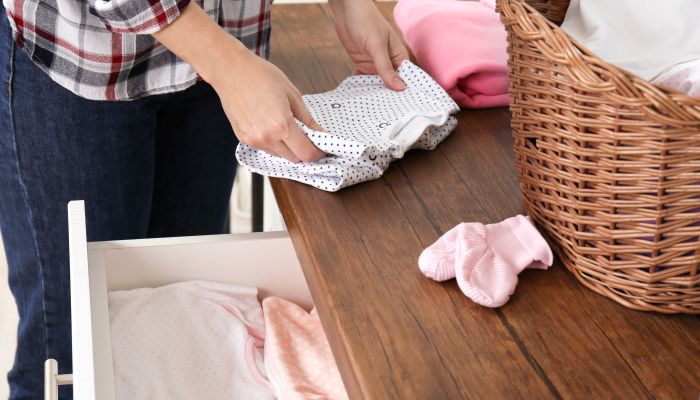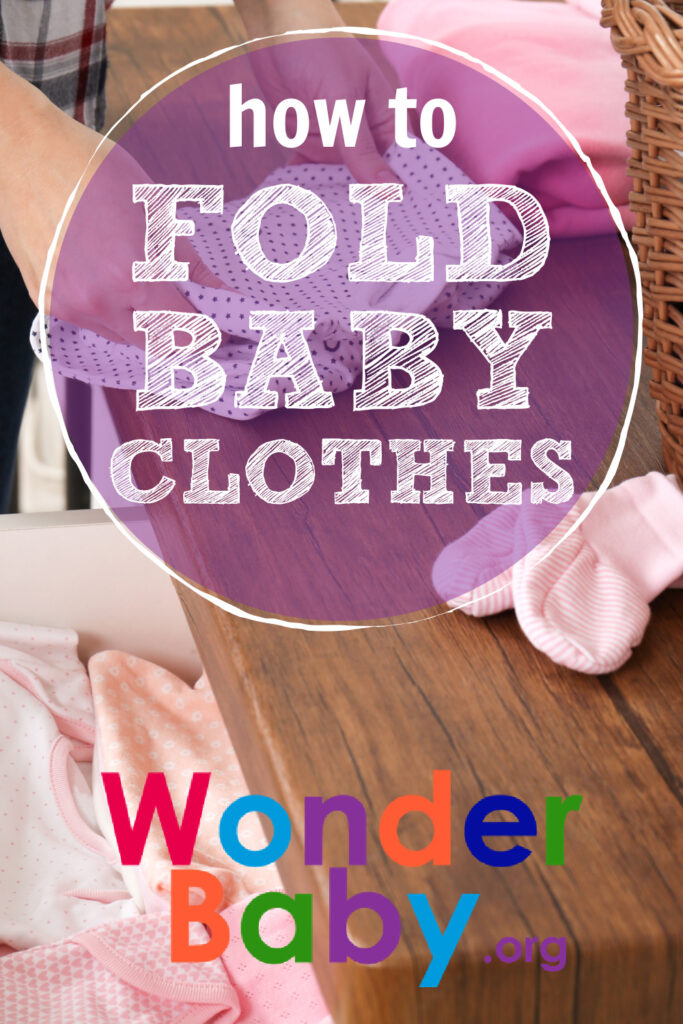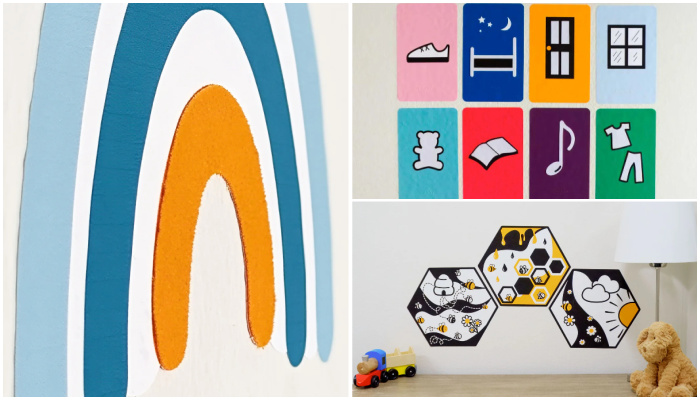How to Fold Baby Clothes: KonMari, Traditional & More!

- The KonMari folding method for baby clothes saves space and minimizes wrinkles.
- Filing baby clothes into the drawer instead of stacking them makes it easier to locate items without disturbing the other clothes.
- Other popular organization methods for baby clothes include traditional folding, the No-Fold method, as well as rolling and hanging clothes.
If you’re preparing for a new baby, you might be wondering how to fold baby clothes. Baby clothes are tiny and often the shape of them can be difficult to fold. Or maybe you’ve been using a traditional folding technique for a while and still keep ending up with messy drawers and wrinkled outfits. If this sounds familiar, you might want to try a new method like KonMari for folding baby clothes.
The KonMari style of folding clothes can be used to fold baby onesies, pants, dresses, and even those teeny-tiny socks your baby wears. Keep your baby’s clothes organized and wrinkle-free with these step-by-step instructions on how to fold baby clothes using the KonMari method.
The KonMari Method for Folding Baby Clothes
The KonMari method of organization can be applied to tidying up your entire house, and that includes folding baby clothes. When you fold clothes the Marie Kondo way, you’ll save space, minimize wrinkles, and be able to find everything easily.
Before you start, you’ll want to empty out your baby’s dresser drawers. This might be overwhelming at first, but you’ll thank yourself later when everything is neatly folded and you no longer have messy drawers. And once you get through the initial stage of organization, maintaining it will be much easier.
When it’s time to fold your baby’s clothes, you’ll need to lay each item flat on a clean surface. The KonMari method has more folds than other folding techniques, and each item will become a little square that can stand straight up on its own. This makes it so you can “file” each item into the drawer.
Marie Kondo’s filing method means that you’ll spend less time looking for outfits, and you won’t make a mess in the process. So, while it might seem like you spend more time folding clothes with this technique, you’ll save time getting ready each day.
How to Fold Onesies Using KonMari
Chances are, you have a lot of onesies, and your little one cycles through them quickly. Using the KonMari method to fold them will help keep them organized and easy to find in the drawer.
To fold onesies using the KonMari folding technique, follow these steps:
- Lay the onesie flat on a clean surface, smoothing out any wrinkles.
- Fold the onesie inwards lengthwise so the sleeves are stacked.
- Tuck in the sleeves so you are left with straight edges.
- Fold the onesie in half horizontally, bringing bottom to top.
- Then, fold it into thirds. You may need to do more or fewer folds depending on the size.
When you’re done folding the onesie, you should be left with a compact square or rectangle. Check to see that the folded onesie will stand upright on its own with the folded side up. Then file it into the drawer, and you’re done!
In this YouTube video, Marie Kondo demonstrates how to fold a short-sleeved onesie step by step (Starts at 0:08):
How to Fold Long-Sleeved Baby Onesies Using KonMari
To fold long-sleeved onesies, you’ll basically do the same thing as you did for a normal onesie with one additional step. You’ll just need to make sure the sleeves are folded additionally in a way that creates uniform edges.
Here’s how to fold long-sleeved onesies using KonMari:
- Lay the onesie flat on a clean surface, smoothing out the sleeves and any wrinkles.
- Fold in half vertically, lining up the sleeves so they are stacked.
- Then, fold both sleeves across the body of the onesie.
- Fold the sleeves in toward the body. You’ll need to fold the sleeves an additional one or two times across the body of the onesie. Everything should be contained in a neat rectangle shape.
- Fold in half horizontally, bringing the bottom of the onesie to the top.
- Fold into thirds horizontally. You may need to adjust the number of folds depending on the size of the onesie.
Just like with the short-sleeved onesies, you should be left with a compact square or rectangle that can stand upright on its own. File it into the drawer, folded side up.
In this video, Marie Kondo shows how to fold a long-sleeved shirt sleeve, which you can use in combination with her onesie folding method (This is the closest I could find to folding a long-sleeved onesie using KonMari):
How to Fold Pants and Shorts Using KonMari
Baby pants and shorts are folded just like grown-up pants using the KonMari method. This method likely isn’t much different from how you already fold pants. You’ll just be folding them into a nice compact shape that can stand up on its own.
Here’s how to fold baby pants and shorts using KonMari:
- Lay the pants flat on a clean surface.
- Fold them in half vertically with the pant legs touching.
- Tuck in any fabric that might be sticking out, especially near the bottom or crotch of the pants. You need to make a somewhat uniform rectangle, but don’t worry if the legs are tapered.
- Fold the pants in half so the bottom meets the waistband.
- For long pants, fold them into thirds from bottom to top. Shorts can simply be folded in half. For either, you may need to adjust the number of folds depending on the size.
Once you have a compact rectangle or square, file it into the drawer folded side up.
This video demonstrates how to fold baby pants and other baby clothes using the KonMari folding method (starts at 0:37):
How To Fold Baby Dresses Using KonMari
Baby dresses are especially prone to becoming wrinkled when folded and placed in a dresser drawer, but the KonMari folding technique aims to minimize that. To help prevent wrinkles in your baby’s dresses, it’s especially important to lay the dress as flat as possible before you begin.
Here’s how to fold baby dresses using the KonMari method:
- Lay the dress flat on a clean surface. Make sure to spread the bottom of the dress out, since it’s probably wider than the top. This will help minimize wrinkling.
- Fold the sides of the dress (including the sleeves) in toward the middle one-third of the way each. You should be left with a rectangle with nice, straight edges.
- Then fold the bottom of the dress up toward the top about one-third of the way.
- Fold up horizontally one more time. Depending on the size of the dress, you may need to fold more or less to get it to the right size.
When you’re done folding, you want to end up with a rectangle or square similar in size to the other baby clothes you’ve folded. If the size isn’t quite right, experiment with more folds in the last two steps. Then you can file it into the drawer without worrying about wrinkles!
This tutorial shows how to fold baby dresses and other baby clothes using KonMari (dresses start at 5:55):
How To Fold Baby Socks and Underwear Using KonMari
Folding baby socks and underwear with the KonMari method is simple and will help keep your baby’s sock drawer tidy. You might want to consider purchasing some drawer dividers to keep things organized, especially if you have a mix of socks, underwear, and accessories in one drawer.
One of the great things about the KonMari method of folding socks is that you won’t stretch out the elastic. Here’s how to do it:
- On a clean surface, stack a pair of socks together, one on top of the other.
- Fold socks in half from bottom to top.
And that’s it! File them into the drawer or organizer like you would any other piece of clothing.
Folding toddler underwear using KonMari is just as easy as folding socks. Here’s how to do it:
- Simply lay a pair of underwear flat on a clean surface.
- Fold the bottom up to the waistband, making a rectangle with even edges.
- Fold in half vertically two times.
Once the underwear is folded into a compact square or rectangle shape, test to see if they will stand on their own. File them into the drawer.
Watch Marie Kondo demonstrate folding baby socks and underwear in this video (starts at 0:30):
How KonMari Differs from the Traditional Folding Method
The KonMari folding method differs from the traditional approach to folding clothes in a few ways. These include both the way the clothes are folded as well as how they’re organized in your dresser drawers.
In the KonMari folding method, clothes are folded in a way that helps save space and reduce wrinkles. You’ll notice that KonMari often requires more folds than the traditional method of folding baby clothes. The additional folding can help minimize wrinkles that you might otherwise have with a traditional folding method, while also making it easier to fit more pieces of clothing in a small space.
After you’ve folded your baby clothes, how you organize them in the drawer is equally important. The folded clothes are filed into the dresser drawer rather than stacked. This means that you’ll be able to see everything in the drawer at the same time. Plus, it makes it easier to remove an item without disturbing everything else.
Organizing Clothes with the No-Fold Method
If you’ve had enough of folding laundry and are looking for a different option, you might want to consider organizing your baby’s clothes with the No-Fold method. Yes, you read that right—many parents have figured out a method to skip folding their kids’ laundry altogether. And since research has found that the average mom spends almost 18 hours a week on housework, you might want to consider this time-saving strategy.
To organize your baby’s clothes using the No-Fold method, you’ll want to use bins for organization rather than a dresser. This helps to reduce wrinkles since you won’t be packing everything into a small drawer. You’ll also need to promptly remove clothing from the dryer, giving each item a quick shake before tossing them into the laundry basket.
The No-Fold method is best if your child wears a lot of synthetic fabrics and cotton blends, since 100% cotton tends to wrinkle more. This method will take up a bit more space, and may even require you to cut back on your child’s wardrobe.
How to Organize Baby Accessories in Drawers
If you have a baby, then you likely have at least one dresser drawer stuffed with a mix of accessories, socks, blankets, and pacifiers. This can make it difficult to find what you’re looking for when you need it. The KonMari method uses drawer organizers to separate accessories by item type and size, a process Marie Kondo calls hikidashi.
Hikidashi works well if you have multiple sizes of drawer organizers, since you likely have a mix of items in one drawer. In a large divider box, for example, you might have your folded blankets and burp cloths, while small items like headbands and pacifiers can go into small boxes. Keep similar items together so you don’t end up with a tangled mess of items in one box.
FAQ
What are some other methods of organizing baby clothes?
Hanging and rolling baby clothes are two other popular approaches to organizing baby clothes. Both of these options can help reduce wrinkles and save space if done right. Like with KonMari, folding or rolling your clothes will also make it easier to locate items that you’re looking for without making a huge mess. You might also consider using over-the-door storage to organize baby clothes. This can be especially helpful for small spaces.

Related Posts

Parenting
Sensory Wall Art: 5 Tips to Create a Room Your Blind or Low-Vision Child Will Love
Even if your child can’t see their surroundings, personalizing and decorating their room with thoughtful, sensory-friendly design can make a big difference in their confidence, independence, and joy.

Parenting
4 Tips to Manage Twins Alone as a Single Parent
Taking care of twins alone as a single parent can feel overwhelming. Learn practical ways to help lighten the load.

Parenting
How to Manage Twin Escalation Syndrome
Discover effective strategies for managing twin escalation syndrome, including promoting individuality and fostering positive interactions.